Considering the majority of your time as a guitarist is spent playing rhythm guitar, it's surprising how under-utilised this skill is in the playing of many. Generally speaking, there is a gross in-balance between the soloing and rhythm guitar skills of the average player. In particular, there is a lack of chord knowledge and application beyond the world of open and bar chords.
Today we are going to balance things up a little by looking at a really cool series of chords that will transform the way you play rhythm guitar. These chords, when used well, will have you sounding super advanced, yet are easy to play. You will be able to easily change between the three most common chord types; major, minor, and dominant, using these shapes, and they are great for soloing with too.
The type of chord I am talking about is known by various names. One I like to use is 'block chords'. These chords fall on the top 4 strings of your guitar, at least the shapes I'm going to show you do, and as they did for me, will totally transform the way you approach rhythm guitar playing.
Rather than get tied down in the theory of these chords, I am instead going to focus on getting you to visualise them up and down the fretboard, as well as show you how you can immediately create awesome sounding music with them. The theory is not necessary to do this and can wait for another day.
My early years of playing guitar was mostly about soloing. Of course I played chords, but it pretty much started and ended with open and bar chords. There were other chords I would play incidentally within a song, but if you asked me if I understood these chords and/or could use them in my playing, the answer would be no. So these chords were useless to me outside the songs I was playing them in.
Finally, while studying jazz guitar in the late nineties, I started to develop my chord playing, and thanks to this my guitar playing really started to take off. Block chords were among some of the chords I was learning to understand and use in my guitar playing at the time. They were a real game changer for me both in a rhythm and solo context.
Thankfully you don't have to be like me and delay your chord development in your playing. Or should I be saying, don't be like me and delay your chord development! Get onto it now starting with block chords.
Have you ever bought one of those chord encyclopaedias that have thousands of different chords in them thinking, right, I'm going to learn all these shapes starting at page 1.
I have, and let me tell you it doesn't work out too well. These books are a great reference, which is exactly what an encyclopaedia is, but useless if you are going to try and go through it from front to back attempting to learn, memorise, and integrate all the shapes into your own playing.
The key to learning and sustaining any chord in your own playing is to see the relationships each has with the other. In other words, when learning a new chord ask yourself 'How does this shape relate to any other chord I may know on my guitar'.
There are several ways you could answer this question, especially as you learn more and more chords. Let me illustrate one way with our first block chord shape, a major 7th chord in root position:
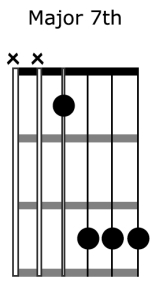
It's very easy to convert the shape above into a dominant 7th chord by altering just one note, like this:
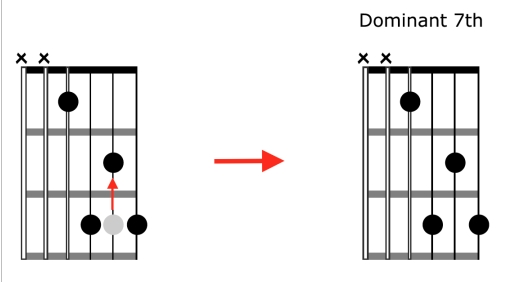
Between a major 7th and dominant 7th chord there is just one note difference. In this case it was the note on the 2nd string of the major 7th shape that had to move down a fret.
As I mentioned previously, don't get caught up in the theory of these chords, or chords in general for now. Just focus on the fact that all you had to do was change one note to convert a major 7th chord to a dominant 7th chord.
Furthermore, to convert our dominant shape to a minor 7th chord, again just alter one note, like this:
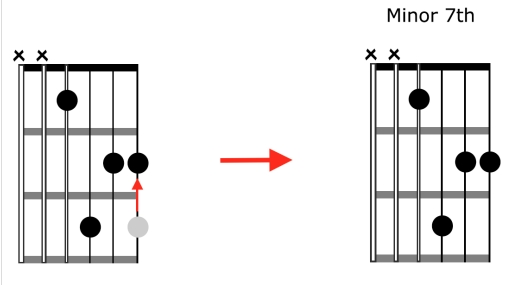
In this example all we had to do was move the note on the 1st string of our dominant shape down one fret.
Now isn't that so much easier than learning your major, dominant, and minor chord shapes in isolation. This is how to visualise block chords on your guitar.
We can easily increase our block chords and the amount of real-estate they occupy on the fretboard by playing inversions of our root position forms above.
What are inversions?
In a nutshell, it's when a note, other than the root, is the lowest note in the chord. However, as mentioned previously, our focus remains with visualising and applying these chords, not so much the theory behind them.
Let's take our major 7th root position block chord from earlier and add the inversions of this chord:

As you can see in the diagram above, our major 7th chord runs up the length of the fretboard. By the time you get to the 3rd version form, it's time to go back to the root position again, only it would be an octave higher.
The highlighted note in the each shape above is the root note. If you can identify the root note in a chord, and how that chord relates to the root note, it will help greatly in being able to find the chord you are after.
As was the case with our root position block chords from earlier, we can derive our dominant and minor 7th chords from the shapes above by simply changing one note:

Above is a diagram showing you the major, dominant, and minor 7th block chord forms, plus inversions so you can use them all over the fretboard.
Approach the shapes above in the following two ways:
By row (horizontally) so you are playing each of the four shapes of the one chord type (eg. Major 7th).
By column (vertically) so you are playing one of each chord type in the same position on the fretboard. This illustrates the similarities between each shape.
OK, so we have three of the most common chord types used in music, and four positions to play each of them up and down the fretboard.
Now what do we do?
Apply them musically is what we do! You could know thousands of chords on the guitar, but if you don't how to use them in a musical context they are useless to you.
So let me give you an example of applying our block chord forms using what is known as a II V I progression. This progression pulls the II, V, and I chord out of a key, giving you a minor, dominant, and major chord respectively.
Here is a II V I progression in the key of G:
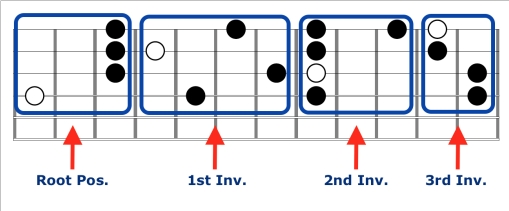
Below is an example of applying some of our block chord forms to this progression:
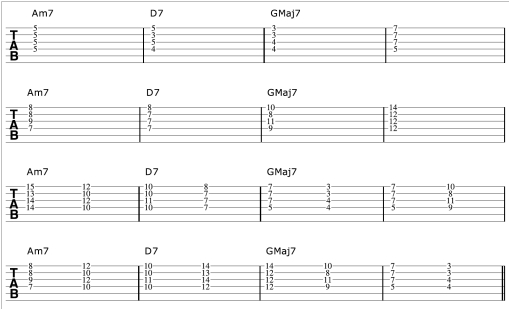
To continue highlighting how each block chord form relates to another, I have kept the shapes I am using within the same position on the fretboard for each rotation of the progression above.
You will notice I am moving between block chord forms for the last two repeats of the II V I progression, even though the chord itself has not changed.
For example on the Am7 and D7 chords I am playing two shapes, and on the G major 7th I am playing between four shapes. Moving through your block chord forms across a static chord like this, brings movement and interest to the progression. This is just a tiny preview of the possibilities block chords can bring to your acoustic guitar playing.
Learn, apply, and master these acoustic chord shapes for your guitar playing, with three approaches that will have you creating great music straight away.
Specializing in online acoustic guitar lessons, Simon Candy is based in Melbourne, Australia where he runs his own guitar school.